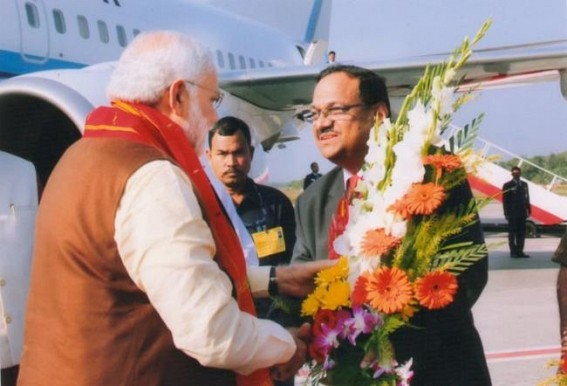G.Kameswara Rao,former Chief Secretary, IAS (Retd)

PHOTO : Chief Secretary G.Kameshwar Rao greeting Prime Minister Narendra Modi at Agartala Airport on Dec 1,2014. TIWN File Photo
Growth of natural rubber plantation has been one of the important success stories of Tripura. Rubber has been identified as one of the thrust areas in Tripura. In view of its suitability to the terrain and acceptability amongst the people. In terms of area under rubber cultivation, estimated to be about 62,000 hectares. (ha), it ranks second at the all India level after Kerala. As per latest statistics, rubber production in Tripura is around 37,277 MT (2013-14), Contributing an annual income of around Rs.600 Crore to the State’s economy.
In common practice, individuals, groups and institutions plant Rubber. The Block plantation approach (BPA) introduced in Tripura has emerged as a good example of an initiative where the cohesive development of the rubber sector has resulted in the empowerment of tribal communities to raise, manage and sustain cultivation of the crop.
The BPA was introduced by Shri G. Kameswara Rao, IAS, Ex-Director and Secretary, Tribal Welfare Department, Government of Tripura and Dr. A. K. Krishna Kumar, ex-Joint Rubber Production Commissioner, Rubber Board of India, Agartala in the year 1992. The availability of large quantities of high quality rubber helped in setting up rubber based industries in the state. Most of the industries are located at present in the Rubber Park.

There is a history of Jhum (roving) cultivation by tribal families in certain forest areas of the state, a practice which has survived for 9000 years in the world. Jhum cultivation is economically unsustainable. Rubber plantation in Tripura is generally taken up on uplands (locally called tilla). These lands are ideally suitable for rubber cultivation as unutilized and follow in nature. The BPA has brought these unutilized lands into productive use, thus contributing to the economic wellbeing of small and marginal farmers and jhumia tribal families.
Evolution of Rubber Industry in the State
The first rubber plantation was under taken by the forest department in 1963. Thereafter, in 1976, the Tripura Forest Development Plantation Corporation (TFDPC) raised rubber in leased forest land of about 10,000 ha. Currently, rubber cultivation is one of the principal sources of occupation for the tribal population.
Several state level studies indicated the possibility of increasing the area under rubber plantation to about 100000 ha in the state. Hence, tribal welfare department, Government of Tripura initiated an ambitious programme to increase area under rubber plantations. This programme was implemented with assistance from Government of Tripura, the Rubber Board and the World Bank. The BPA was adopted by the Rubber Board, the World Bank and the Tribal Welfare Department. Normally, the Rubber Board does not involve in taking up plantation works of farmers. In the BPA, the crop is raised, maintained and handed over to ST Farmers by the Rubber Board after 6 years but the financing of the project is done by the State Government and the Rubber Board and the World Bank (1994 – 2000). The BPA plantations are still being raised by the Rubber Board even today with joint funding by the state Government and the Rubber Board.
Objective:
The Tripura Block plantation project is a joint venture between the Government of Tripura and the Rubber Board. The Principal Objective of the project is the economic upliftment of tribal Jhumia families engaged in rubber plantation on allotted lands, through an integrated approach. The participation in rubber plantation would enable the farmers to shift from jhum cultivation to a more settled form of livelihood and would also promote an eco-friendly method of cultivation. By 2015, the project covered 3724 ha and benefited 3490 jhumia families with an annual income of Rs. 60 Crore. All the 3490 families have crossed poverty line with annual net income of Rs. 1.86 lakh per family. The total investment so-far was Rs. 35 Crores in the BPA project.
Incentive Schemes of the Rubber Board
- Planting Material Subsidy
- Fencing subsidy
- Planting grant
- Smoke house subsidy
- Sheet rollers subsidy
Salient features
Organisation and Structure
- The Block plantation officer (BPO), appointed by the Rubber Board, ensures that all inputs required for plantation of rubber are readily available, and facilitates coordination with local authorities of the State Government.
- The BPO is the focal point for all services at the block plantation level. Several ongoing state government schemes like immunization drives, health camps, sanitation campaign and animal husbandry camps are organized for the families in the block plantation.
- The Rubber Board and Government of Tripura share 80% of the cost of raising rubber plantation and the beneficiaries contribute 20% through their own labour.
Continued.....
Full article avaiable at this link below:
http://www.tripurainfoway.com/pdf/Successful-Rubber-Block-Plantation.pdf
- Why Modi’s BJP swept key India regional elections
- TIWN’s landmark legal victory against BJP Govt’s Illegal attacks to shutdown fearless Media
- India to be world's third-largest economy by 2030 -S&P Global Ratings
- Tripura's Dark Era : Mafia style Brutal attacks on Journalists, fight for your Citizen rights !
- How to access tripurainfoway.com via HOLA from India



